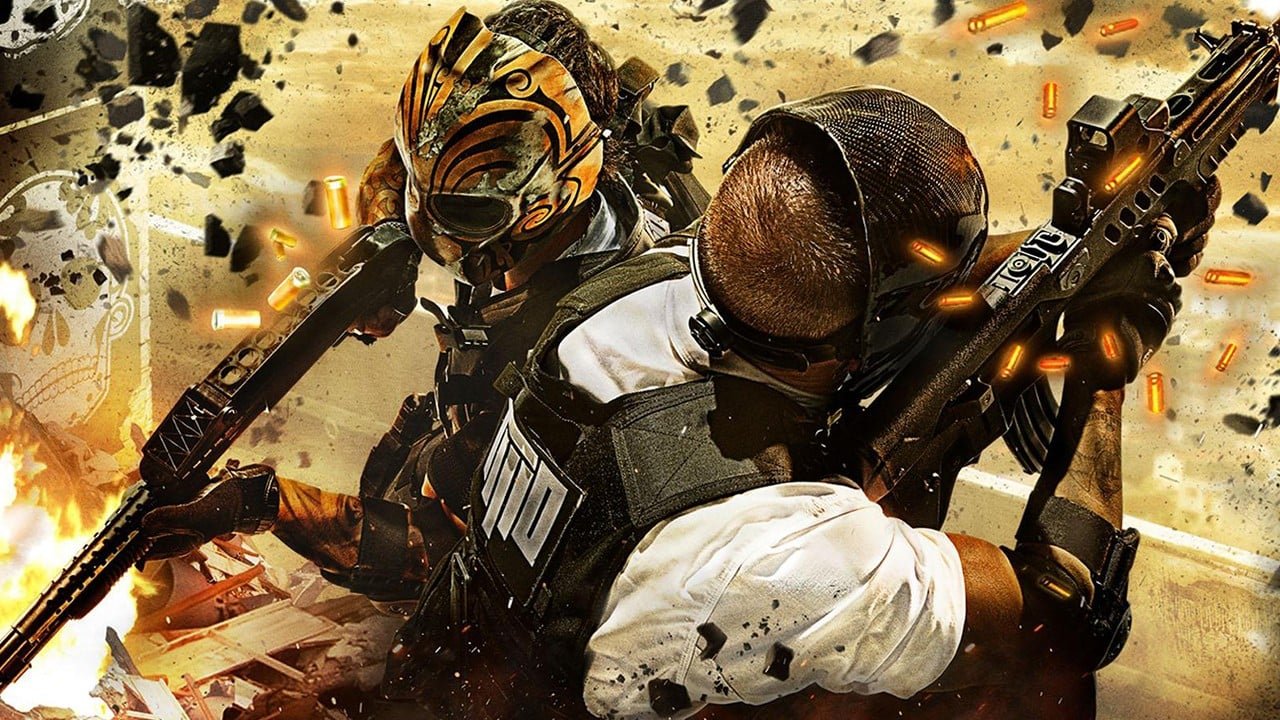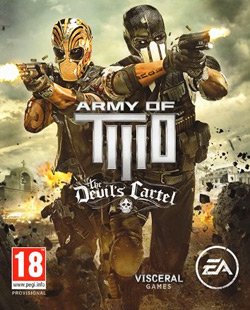It’s pretty obvious just by reading the title that Army of Two: The Devil’s Cartel is meant to be played with a friend. You and your friend (or AI partner if you decide to go about this game alone) will work your way through each scenario, for the most part, together, and that’s the best part about this game. Playing with a friend is enjoyable; figuring out who is going to draw fire and who is going to flank (as well as why one of you keeps dying) can result in some heated argument. This all adds up nicely on paper and should result in a good game. Unfortunately, The Devil’s Cartel falls flat in some other key areas.
The chief problems is that the game suffers from an identity crisis. Army of Two and its sequel The 40th Day, found a happy medium between over the top violence/destruction and over the top (and often hilariously lame) humour. The two main characters of those games, Elliot Salem and Tyson Rios, could high five each other in the middle of play or air guitar after an intense gunfight, adding to the feel that this game knew it was a parodying the genre.
In The Devil’s Cartel, it feels like the developers weren’t sure what they wanted this game to be. The one-liners aren’t as common (and aren’t nearly as funny, or so bad you can’t help but laugh) and the story takes itself more seriously. The entirety of the game takes place in Mexico, (ranging from the streets of Mexico to the buildings of Mexico and the tunnels of Mexico) your enemies comprised entirely of Cartel goons. Salem and Rios take the back seat for most the game, with players taking control of a pair known only as Alpha and Bravo. You begin the game escorting a politician wanted by the Cartel leader, things go south and chaos ensues from there.
That’s pretty much all the plot you need to know.
There is an interesting but completely predictable twist halfway through the story (so predictable that the characters actually mention they should have seen it coming) but aside from that it’s pretty by the numbers. You’ll work with the Salem and Rios for a little while, run into other members of your organization, T.W.O, often ending with death, but much of the game is Alpha and Bravo going about things themselves.
Alpha and Bravo are, unfortunately, just as generic as characters as their names would have you believe. One is your textbook tough guy wanting to run into danger, the other a little more cautious in how he approaches things. I won’t hold up Salem and Rios as the bastions of videogame characters but at the very least they had distinct voices, with Rios having the benefit of being voiced by Nolan North. Alpha and Bravo sound far too similar, and it wasn’t until the last third of the game that I could tell which voice was which because neither stands out.
Speaking of Nolan North, he does not return to his role in this game, which is a shame because I thought that character had an interesting arc during this game. That’s not to say the new actor does a poor job, his delivery is fine. It is just very noticeable that the actor has changed since the voices aren’t at all similar.
Having said all that, there is very little fundamentally wrong with the way this game plays. The shooting is near identical to the previous titles in the series and most third person shooters on the market. The cover mechanic is troublesome though. A single button is used to snap your character into cover (much like everywhere else) but the game doesn’t seem to understand where you want to go. A very small indicator will pop up on screen signifying where your next destination will be, but it’s hit or miss whether or not you can get the icon to where you need it.
You can have your character standing right beside a wall and the game won’t get that you want to duck under it. Sometimes it will decide you meant to run right through a hail of gunfire and grenades to take cover behind a car right beside your enemies. When it works, it’s competent. But it rarely ever works.
Play long enough and your Overkill meter fills, letting you unleash a rain of bullets without being vulnerable to return fire. With Overkill activated the game slows down, letting you get a feel for where everybody is before taking them out. Limbs will rip apart and blood will spray in all directions while in Overkill.
Perhaps the best part of The Devil’s Cartel is the customization options. Much like in the first two games, you can upgrade your weapons to increase the clip size, add a scope, silencer or a grenade launcher. You can also just make cosmetic changes to your weapons and characters to change the colour of your gun, change the style of your mask and attire. I can’t tell you how motivated I was to unlock and buy a specific mask. It’s meaningless overall in terms of how the game plays, but it’s the small things like this that generally add to the overall enjoyment of a game.
All of this can be done by spending the money you earn after each mission. That money is earned based on how you perform in each mission. You’ll get money for the obvious things like kills and headshots, but you can earn bonus dollars for headshots and melee kills along with taking down tougher enemies like brutes or (most importantly) working as a team.
If you don’t have a co-op partner to play with the allied AI won’t hold you down. When you’re down the AI will come to your aid and is generally smart with how it goes about eliminating your foes. The same can’t be said for the enemy AI though. At times they’ll just stay in one spot and wait for you to come up and end their life with a satisfying melee kill. Other times they’ll just blindly lob grenades. If you run into a big group in a constrained area you’ll run into some difficulty progressing, that’s about as hard as this game gets.
In the end though this is not a bad game, it just feels soulless. It doesn’t know what it wants to be. The Devil’s Cartel ditched the self-aware parody feeling of the first two titles and tried moving towards a more serious tone, but then pulled it back to the comedy slightly, and that didn’t work. Army of Two now feels like it’s trying to please fans of all genres to broaden the potential audience, but ultimately fails when it comes to standing out at anything.
I didn’t care much about what was happening on screen, didn’t have a personal attachment to any of the new characters introduced. Even when something marginally interesting happened, it was surrounded by so much mediocrity, it didn’t feel like it mattered. The game teases another sequel at the end, but if that game ever comes to fruition (and I doubt it will anytime soon), whoever heads up that project needs to re-evaluate what Army of Two is and should be.
If you can find a friend to play with (whether online or split-screen) this game can be fun. Look past the generic story and bland characters and just enjoy the co-op. That’s the way to play this game. But just because something is fun doesn’t mean it’s good. This game feels lost, not knowing exactly what it wants to be, and is forgettable at the end of the day. It’s sure to be a let- down to most the fans of the first two games, and fans of the genre at large. There are better third person shooters available, seek those out.





